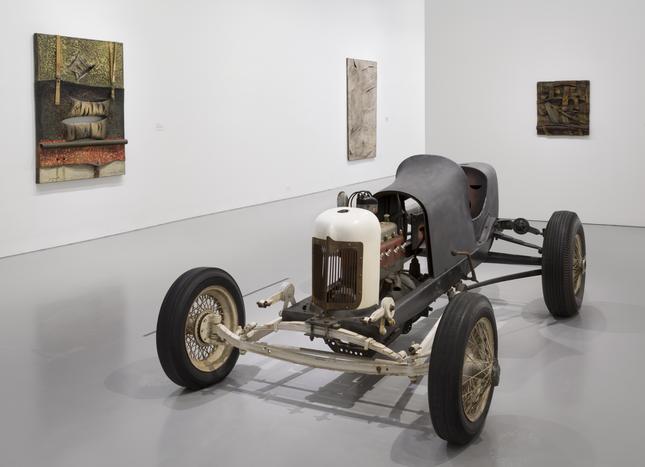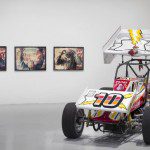‘Salvatore Scarpitta: Traveler’ at the Hirshhorn
By • October 23, 2014 0 1108

The word “terrain” comes to mind a lot at the Hirshhorn’s current exhibit, “Salvatore Scarpitta: Traveler.” Scarpitta (1919–2007), an Italian-American who grew up in Los Angeles in the 1920s, was a unique presence in postwar American art for reasons of both style and subject. As an artist, he negotiated many terrains and bridged many divides: of painting and sculpture, abstraction and realism, elegance and vulgarity, and most whimsically of all, of fine art and competitive sprint car racing.
Scarpitta moved to Rome after high school to study art. When World War II broke out, he served in the United States Navy, ultimately working as a Monuments Man, where he was tasked with safeguarding art and historic monuments from war’s destruction.
Perhaps the first of many fascinating career choices, Scarpitta stayed in Rome after the war and set up his studio on the famous Via Margutta, a narrow street rich with artistic culture, popularized by Gregory Peck in the 1953 film, “Roman Holiday.” This decision in itself alludes to a kind of fixation the young artist may have had with confronting destruction and devastation firsthand, as well as a need to help build things back up.
His work from the mid-to-late 50s directly confronts the destruction of the War, the failure of Fascism and the fall of Mussolini—an event which had forced him and his first wife, an Italian Jew, into hiding in the Apennine Mountains in 1943.
In these dimensional works that are part painting, part sculpture (and later deemed “Extramurals”), layers of fabric are wrapped around stretcher bars or wood panels. Folds of cloth, canvas, medical bandages, gurney straps and swaddling envelop the picture plane, creating precarious but steady surfaces. Scarpitta spattered the surfaces with paint, resin, tea, pencil marks and what seems like any material that was on hand. The result is a surprisingly elegant glaze over a woven landscape of coarse fabric. As a wall panel in the exhibit beautifully points out, they are “mottled, hide-like” surfaces, whose natural, undulating folds and weaves inform the surface with naturally occurring shadows.
It was this breakout work that caught the attention of legendary New York City art dealer Leo Castelli who convinced Scarpitta to move back to New York and exhibit in his gallery. Once there, Scarpitta rekindled his childhood obsession with cars.
As a boy in L.A., Scarpitta had been a regular spectator at the treacherous Legion Ascot Speedway, where he marveled at the feats of the drivers and mourned those who died in crashes. As an adult, he began using car parts—some scavenged from fatal wrecks—in his paintings. Like the Extramurals, the car-part paintings are cut and bruised, bandaged and bound. However, in contrast to his previous works’ muted monochrome, these works employ almost technicolor vibrancy.
This reignited passion for racing eventually led him to abandon abstraction for a radical, flesh-and-bones realism. Adding car parts to his paintings was no longer enough—he needed to make the actual cars. Between 1964 and 1969, Scarpitta created six full-scale vehicles, each in the souped-up, vintage go-kart style of the racers from his childhood.
The last phase of Scarpitta’s career took a different, equally unusual turn. He began building sleds in the 1970s and continued making them for the rest of his life. Made from scavenged objects, these nonfunctional sleds represent a more primitive means of transportation, as well as the solitary nature of art.
While some of the sleds stand upright as sculptures, others are mounted on canvas and hung like paintings. “Snowshoe Sled” (1974) looks like a Rothko collage, the sled hung in the center between color fields of yellow and green. It is oddly detached from anything in this world, the sled floating like a bar of color in the center of the canvas.
While they are obviously sleds, the works are also sculptures in a very natural sense, balancing Scarpitta’s remarkable craftsmanship and sense of structure in delicate harmony. They are his most inspiring creations, where his abstract sensibilities merge with his insistence for form and purpose of function to make works that seem alive. They are objects perhaps meant to traverse unknown landscapes of our unconscious, tantric tools to help guide us to the far reaches of our human condition. And if nothing else, they sure look fun to ride.
Come hear Hirshhorn Director Melissa Chiu speak at our Cultural Leadership Breakfast, this Thursday, Oct. 9, 8 a.m. at the George Town Club.
To read more on this exhibit, visit Georgetowner.com
- Installation view of “Salvatore Scarpitta: Traveler” at the Hirshhon Museum and Sculpture Garden.



